
Microfocus Application Lifecycle Management (ALM) is a test management tool that supports different phases of the software development life cycle. It supports requirements management, test planning, test execution, defect tracking, and reporting. Using Microfocus ALM, different teams can effectively manage and monitor their application delivery process. In this article, we will discuss more details about Microfocus ALM.
What is ALM?
Application Lifecycle Management is the process of managing an application from its beginning phase to its end. This includes different phases like planning, development, testing, deployment, and maintenance. Microfocus ALM provides a structured approach to managing all these phases and ensures quality and compliance throughout the life cycle.
ALM provides robust features for requirement management, test planning, test execution, and defect tracking. It supports end-to-end traceability, ensuring that each requirement is covered by corresponding test cases and that any defects are linked back to their root causes. The tool also offers powerful reporting and dashboard capabilities, enabling real-time monitoring and analysis of project status, which helps in making informed decisions.
Key Features of Microfocus ALM
Let’s go through the key features of Microfocus ALM:
- Requirements Management: Allows teams to capture, manage, and track requirements throughout the project lifecycle.
- Test Planning: Facilitates the creation and management of test plans and test cases.
- Test Execution: Supports the execution of manual and automated tests.
- Defect Tracking: Manages the entire defect lifecycle, from logging to resolution.
- Reporting and Analysis: Provides robust reporting and analysis capabilities to monitor project progress and quality.
- Release Management: Define and manage release cycles and associated milestones. Also, associate requirements, tests, and defects with specific releases to monitor progress and quality.
- Integrations: Integrates with various development and testing tools, enhancing its capabilities and providing a seamless workflow.
Benefits of Using Microfocus ALM
Micro Focus Application Lifecycle Management (ALM) offers numerous benefits for organizations looking to manage and streamline their software development and testing processes. Here are the key benefits:
- Centralized Management: ALM provides a single repository for all project-related artifacts, including requirements, test cases, test results, and defects, enabling easy access and management. You gain visibility into the entire application lifecycle, improving oversight and control.
- Enhanced Collaboration: Built-in tools facilitate communication and collaboration among team members, reducing misunderstandings and improving productivity. Real-time dashboards and reports keep all stakeholders informed about project progress and quality.
- End-to-End Traceability: ALM ensures complete traceability from requirements to test cases and defects, allowing teams to verify that all requirements are met. You can easily assess the impact of changes in requirements on test cases and defects.
- Efficient Test Management: ALM provides tools for creating, organizing, and executing test cases, making test management more efficient. Integration with automated testing tools like UFT (Unified Functional Testing) enhances test execution efficiency.
Challenges with Using Microfocus ALM
While Micro Focus ALM offers numerous benefits, organizations may also face several challenges when using this tool. Here are some common challenges:
- Complexity and Learning Curve: ALM’s comprehensive feature set can be overwhelming for new users, requiring significant time and effort to learn and master. Organizations may need to invest in extensive training for team members to fully utilize ALM’s capabilities.
- Cost: ALM can be expensive, particularly for small to medium-sized organizations, due to licensing fees and maintenance costs. In addition to licensing, costs for training, customization and ongoing support can add up.
- Integration Challenges: Integrating ALM with other tools and systems (e.g., CI/CD pipelines, automated testing tools) can be challenging and may require additional configuration or third-party plugins. Migrating data from other systems to ALM can be complex and time-consuming, with potential risks of data loss or inconsistency.
- Performance Issues: While ALM is designed to scale, performance can degrade with very large datasets or complex configurations, impacting user experience. You may experience slow response times, especially in geographically distributed teams where network latency can be an issue.
- User Adoption: Teams used to other tools or manual processes may resist adopting ALM, affecting overall user adoption and productivity. Ensuring that all team members consistently use ALM and follow established processes can be challenging.
Preview of Microfocus ALM
Let’s see a quick demonstration of how we can create test cases and view the results of test execution using ALM.
Once you install the ALM client, you need to log in with your credentials. After login, the home screen is displayed. You have different options in the left menu like:
- Dashboard: We can create informative dashboards based on our requirements such as releases, requirements, testing, defects, etc.
- Management: Contains details about the releases and repositories where code is present.
- Requirements: All the requirements of the application can be mapped here. Test cases can be tagged for each requirement, which will have a unique ID.
- Testing: This contains the test cases, test runs, and test suites. All the data regarding testing will be present under this tab.
- Defects: We can create defects under this tab. For each requirement, we can see what all test cases are mapped to it and the defects present.
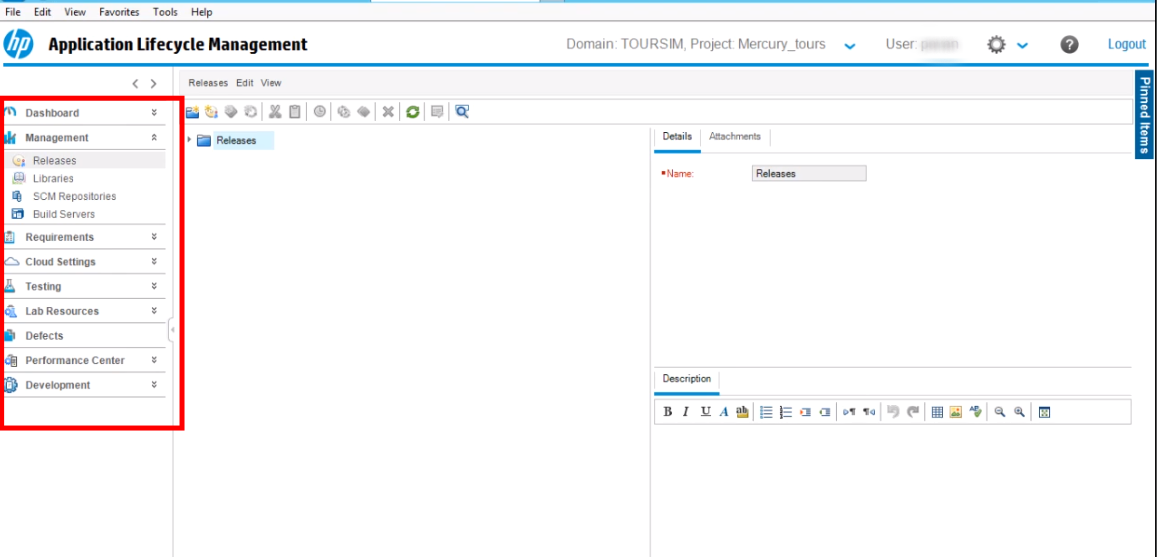
Let us see a simple test creation flow. We need to create the test case in the test plan. We can organize the test case in a folder based on any criteria. To create a new test case, click on the New Test icon.
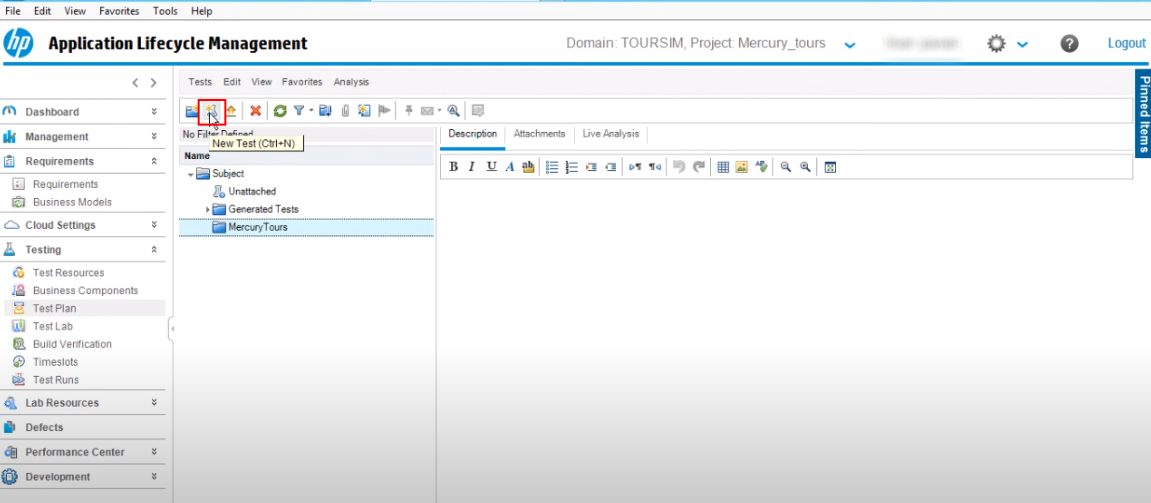
Once you click the icon, a dialog box opens. We can add the test case name and test type, mentioning whether it’s manual or automation, as well as the status and description.
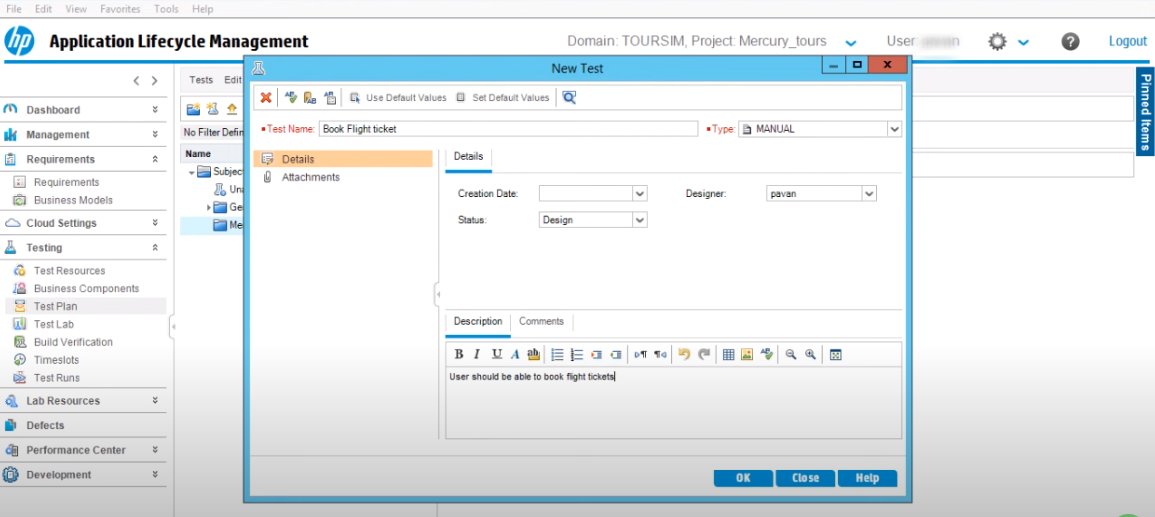
Once you add the details, click the OK button. The test case will be created. Once the testcase is created, you will have different tabs to add additional data like – design steps, parameters, attachments, test configurations, requirement coverage, linked defects, etc.
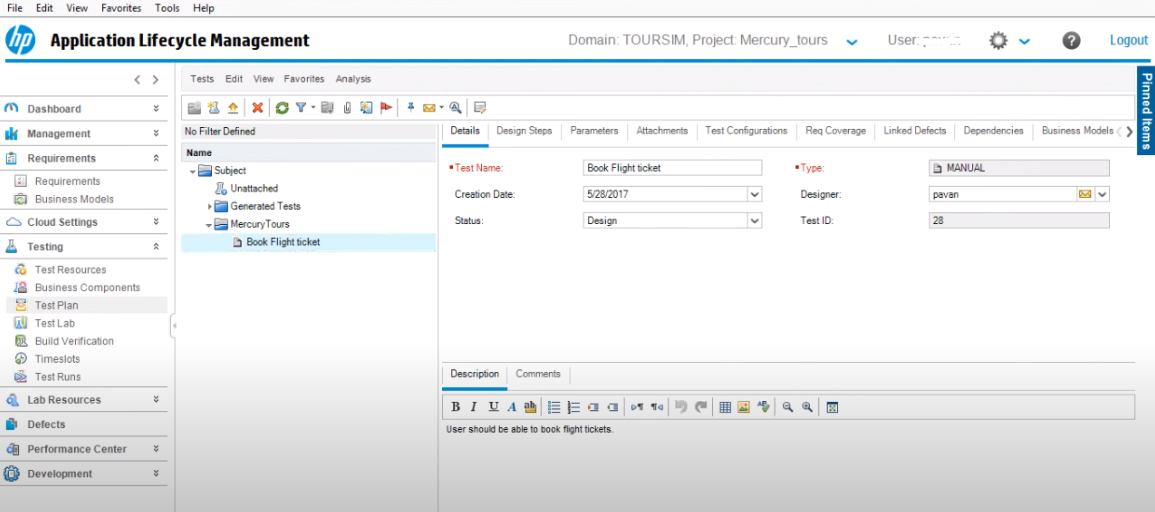
In the above pic, the Test ID number is automatically generated. Now, let’s go to the Design Steps tab. Here, we can add test steps. You can copy-paste the test steps from Excel or create them from scratch. To create a new one, click on the New Step icon.
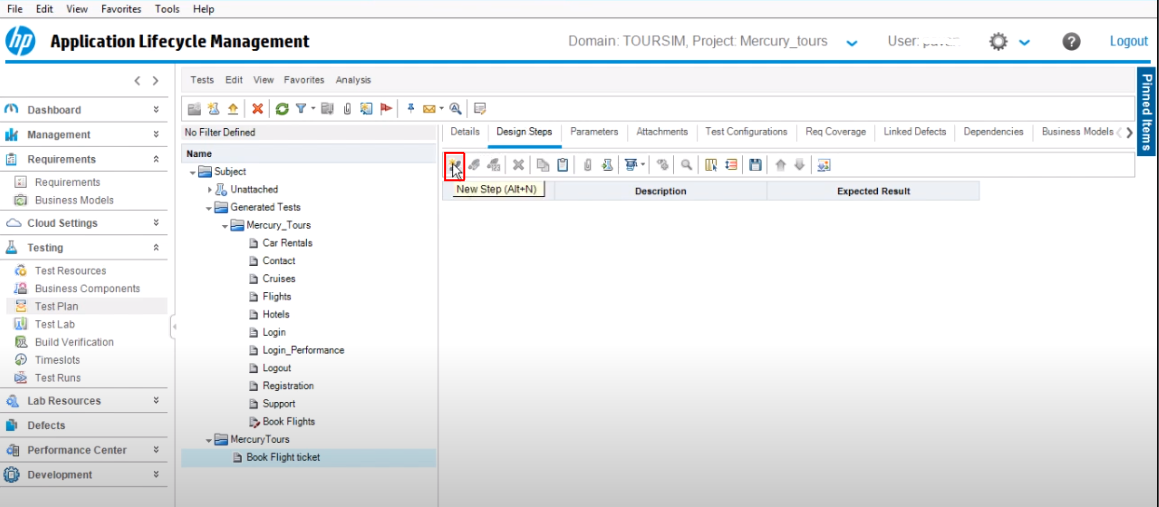
When you click the New Step icon, a new dialogue box opens with the option to add the step name, description, and expected results. Once you add the details, click the OK button.
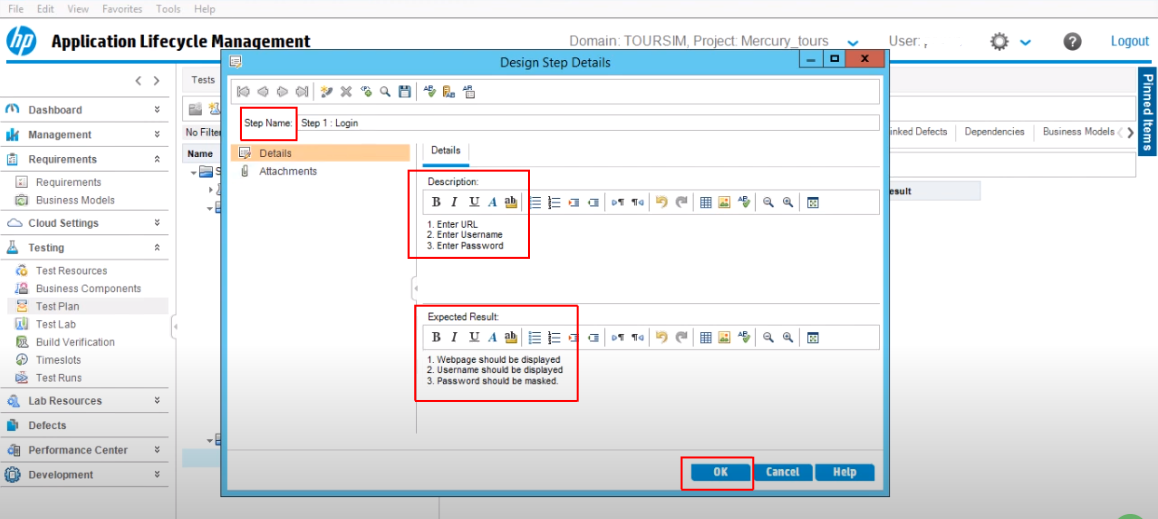
Similarly, you can add all the steps.
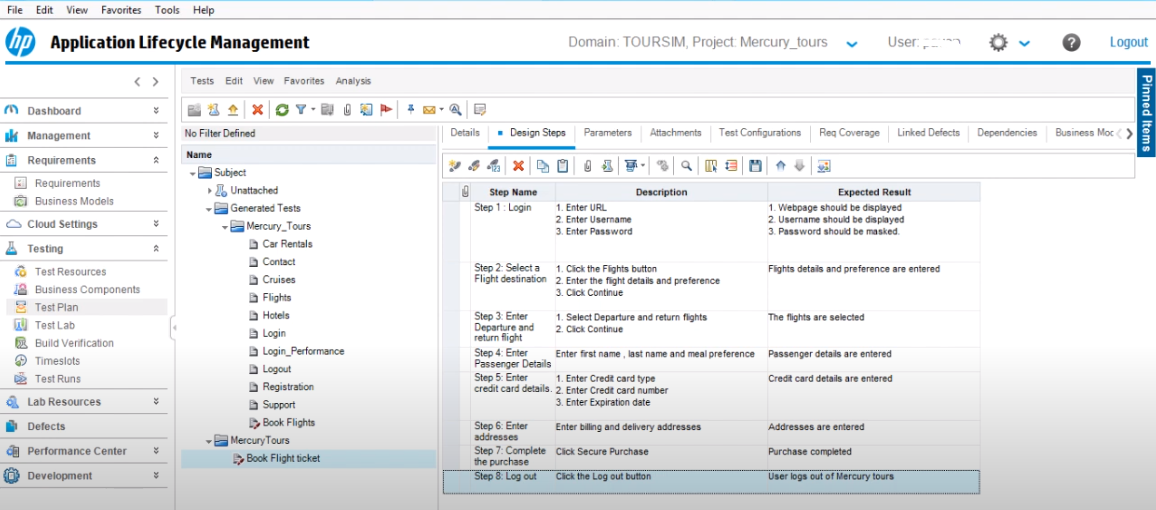
Also, you can link the test case with particular requirements. To do that, click the Req Coverage tab and Select Req. So, the requirements tree will be opened on the left side. To select a requirement, click the move left arrow on the tree, that requirement will get mapped with the test case.
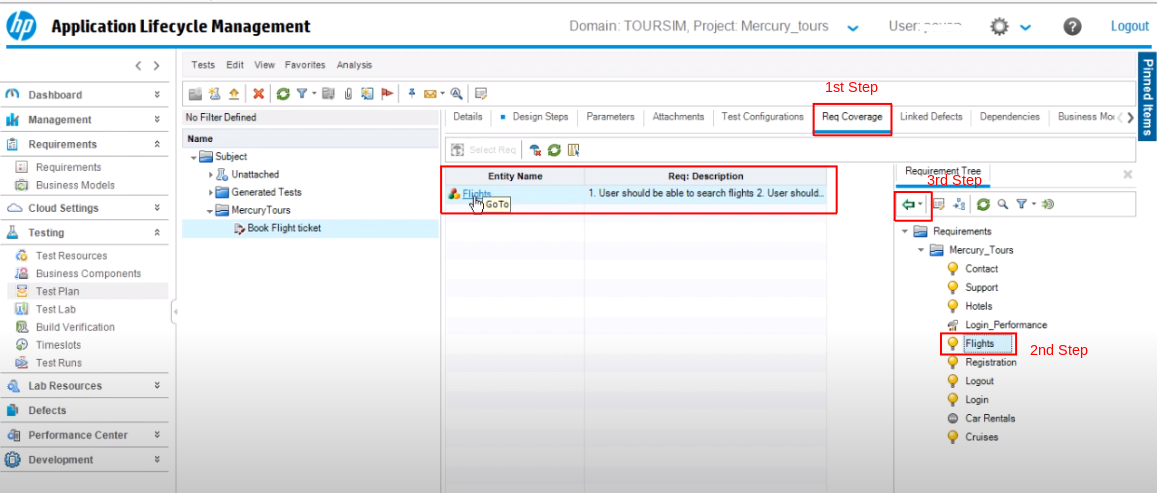
You can create test runs and execute the test cases based on the requirements. The test run shows the details of the test case status. You can click on each test case to see the status of each test step.
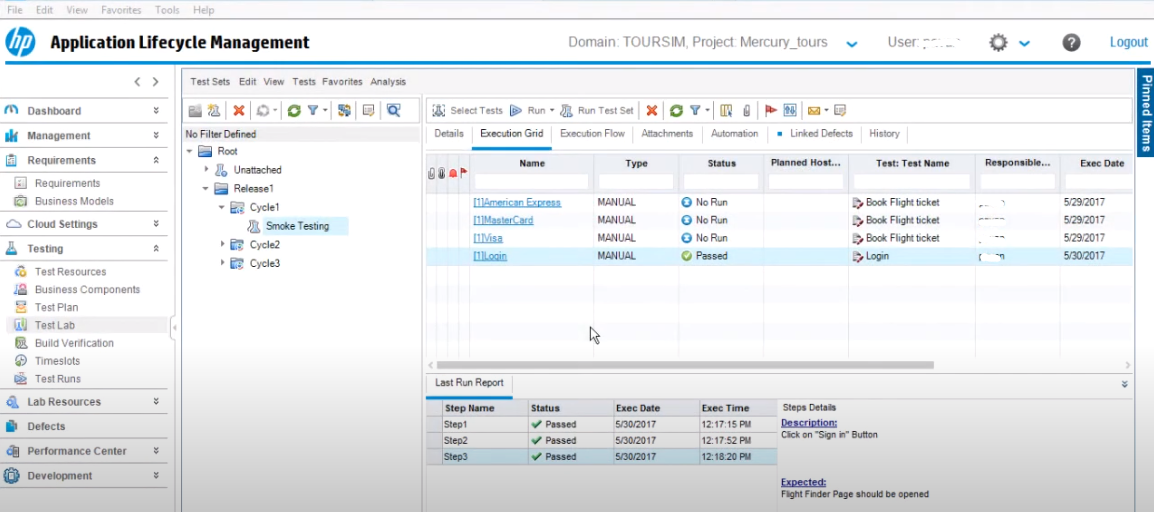
Also, since we can map the requirements to the test case, we can see the status of each requirement based on execution.
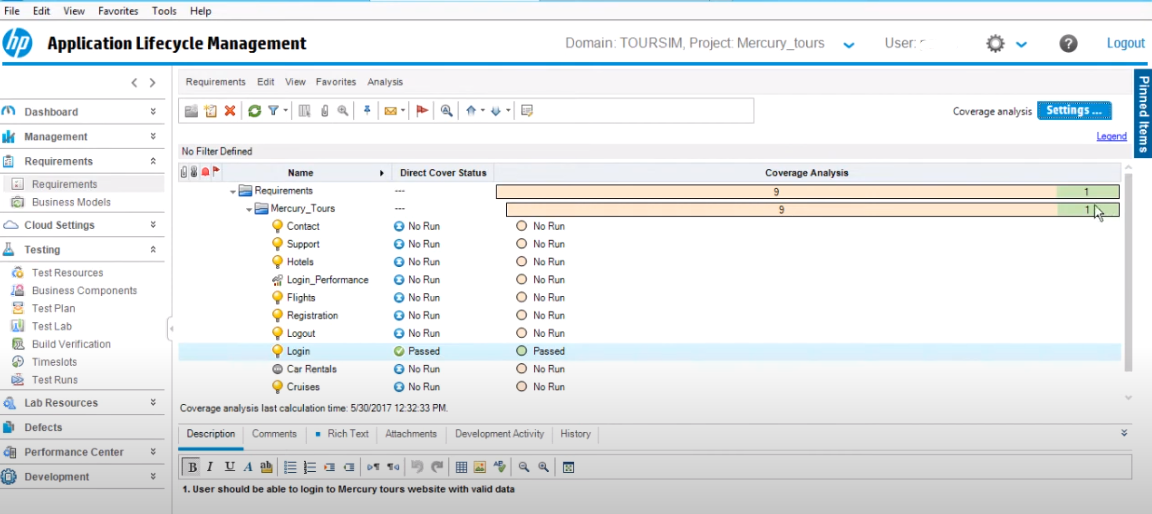
In the above picture, we can see that we have nine requirements; out of that, only one has been executed and passed. If any test case mapped to that requirement fails, then the requirement status will be failed.
Conclusion
Micro Focus Application Lifecycle Management (ALM) stands out as a comprehensive and robust tool designed to streamline the software development and testing processes. It offers numerous benefits, including centralized management, enhanced collaboration, end-to-end traceability, and improved quality and compliance.
However, the extensive feature set of ALM also presents challenges. The complexity and steep learning curve can be a barrier to adoption, requiring significant training and customization efforts. Additionally, the high cost of licensing and maintenance may be prohibitive for smaller organizations.
Ultimately, while Micro Focus ALM offers a powerful solution for managing the application lifecycle, organizations must weigh its comprehensive benefits against the potential drawbacks to ensure successful implementation and utilization.

